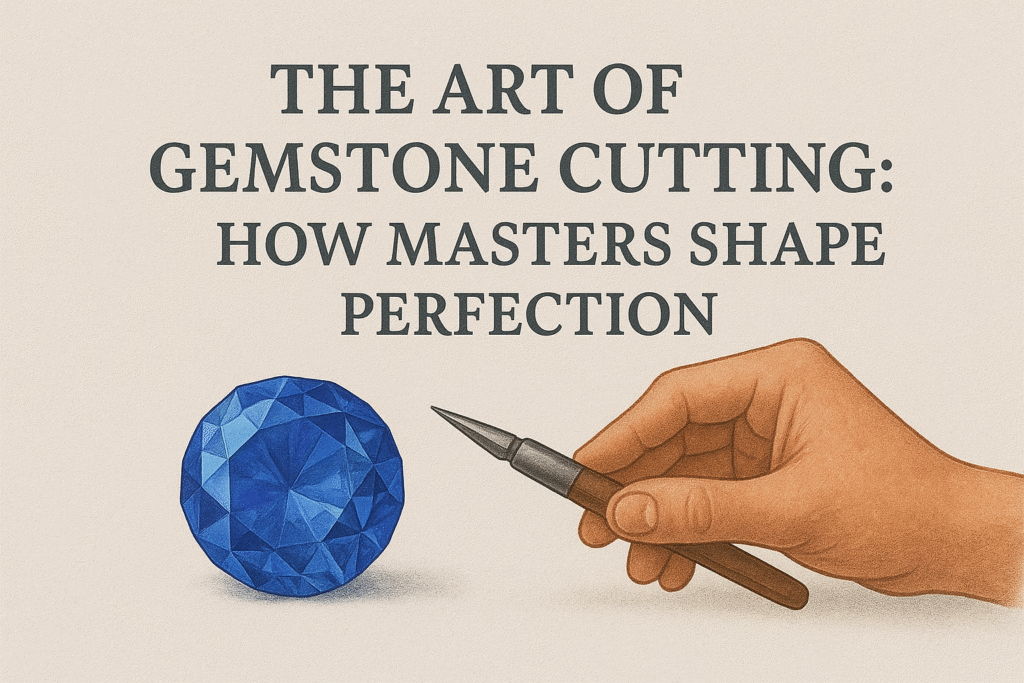When we admire a gemstone sparkling in a piece of fine jewelry, we often forget – its brilliance isn’t just a gift of nature. It’s a masterpiece of human craftsmanship.
Behind every perfectly polished diamond or radiant sapphire lies the art and science of gemstone cutting – a centuries-old tradition that transforms raw, dull stones into dazzling treasures.
Let’s journey into the fascinating world of gemstone cutting, where artistry, geometry, and precision converge to shape perfection.
Table of Contents
🪨 1. From Rough to Radiant: The Journey of a Gem
Every gemstone starts its life as a rough crystal – uneven, cloudy, and often unimpressive. It takes a skilled lapidary (gem cutter) to unlock its hidden potential.
The process begins with a deep understanding of the stone’s natural structure, color zoning, and clarity. One wrong cut can destroy its value; one perfect cut can make it priceless.
This is why gemstone cutting isn’t just a technical process – it’s an art form fueled by intuition, geometry, and years of mastery.
🔍 2. The Science Behind the Sparkle
What makes a gem sparkle the way it does? The secret lies in light reflection and refraction.
A gemstone’s brilliance depends on how efficiently it reflects light back to the viewer’s eye. This is achieved through precise angles and symmetrical facets that guide light within the stone before it exits through the top.
If a gem is cut too shallow, light leaks out from the bottom – making it appear dull. Too deep, and it looks dark at the center. The perfect cut ensures maximum light return – the signature of a master cutter.

✂️ 3. The Types of Gemstone Cuts
Gem cutters use a variety of styles to bring out the best in each stone. Each cut highlights different aspects like brilliance, color, or clarity.
💠 Brilliant Cut
The most famous – especially for diamonds – with 57 or 58 facets designed to maximize sparkle.
🟩 Step Cut
Used for emeralds and aquamarines, featuring parallel facets that emphasize clarity over brilliance.
🔷 Mixed Cut
A blend of step and brilliant styles – perfect for sapphires and rubies, balancing depth and radiance.
🧿 Cabochon Cut
Smooth and polished without facets, often used for opals, moonstones, and star sapphires to showcase inner light or play of color.
Each cut tells a story – of balance, beauty, and purpose.
🧠 4. Precision Meets Artistry: The Lapidary’s Craft
Gemstone cutting is performed by lapidaries, often regarded as artists in their own right.
These masters combine:
- Mathematical precision for perfect angles
- Artistic intuition for maximizing beauty
- Hands-on experience to navigate natural flaws
Using tools like ultra-precision faceting machines, polishing laps, and magnification devices, they shape each stone with micrometer accuracy – often working for hours or even days on a single gem.
Their goal is simple but profound: to reveal the stone’s soul.
🔬 5. Modern Innovations in Gem Cutting
Technology has transformed gem cutting from traditional handcraft to a blend of science and digital precision.
Today’s cutters use:
💻 3D scanning to analyze inclusions and color zones
⚙️ Computer-Aided Design (CAD) to plan facet placement
🪞 Laser cutting tools for accuracy and minimal material loss
Yet, even with high-tech machines, the human touch remains irreplaceable. It’s the lapidary’s eye that decides how to make a gem truly come alive.
💎 6. Why Cut Quality Determines Value
Two gemstones of the same type and size can have completely different values – and it often comes down to the cut.
A perfectly cut gem:
- Reflects more light → more brilliance ✨
- Appears larger → better visual appeal
- Enhances color saturation → deeper tones
- Hides inclusions → clearer appearance
That’s why experts say: “Color may draw you in, but the cut makes you fall in love.”
🌟 7. The Masters Behind the Magic
Around the world, a few legendary lapidaries have elevated gem cutting into a fine art form.
Names like Bernd Munsteiner (the “Picasso of Gems”) and Victor Tuzlukov are known for pushing boundaries – turning stones into geometric sculptures that defy convention.
Their works are exhibited not just in jewelry showcases but in art museums, blurring the line between science and sculpture.
🔮 8. The Future of Gem Cutting
As the gemstone industry embraces AI-driven cutting, sustainable sourcing, and digital design, the future of lapidary art is brighter than ever.
Imagine custom-cut gems designed virtually, optimized for brilliance, and carved with eco-friendly precision.
But even in the age of automation, one truth will remain timeless:
The heart of gemstone cutting lies not in machines, but in the hands and vision of the artist.
💫 Conclusion: Where Nature Meets Human Genius
A gemstone’s beauty begins in the earth – but it reaches perfection in the hands of a master cutter.
Each facet carved, each angle polished, is a tribute to the age-old pursuit of perfection – a moment where nature’s creation meets human imagination.
So the next time a gemstone catches your eye, remember: its brilliance is not just natural – it’s crafted with purpose, patience, and passion.